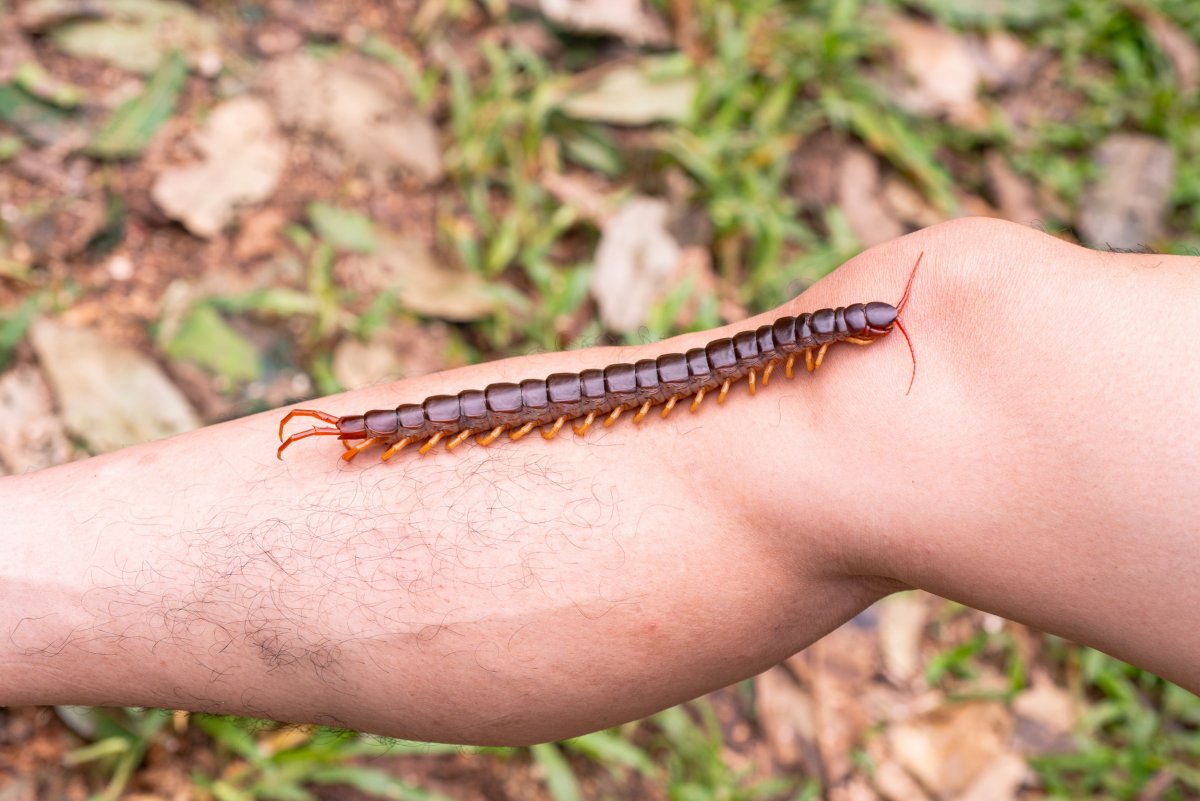The Scolopendra gigantea is a species of centipede that packs a painful, venomous bite.
The species—also known as the giant yellow-leg centipede or Amazonian giant centipede—is the largest known centipede in the world. The carnivorous arthropod uses its powerful venom to feast on small rodents, as well as large insects and reptiles.
Its long, flattened body has up to 27 segments, with 21 pairs of legs. Its first pair of legs double as claws, which it uses to lunge at prey, and administer venom.
The huge centipede can be found in northern Colombia and northern Venezuela, as well as the nearby islands of Aruba, Curaçao, and Trinidad. However, older specimens have been labeled as originating in the U.S. Virgin Islands, Haiti, Mexico and Honduras.
They mostly live under wood, bark and in tropical forest leaf litter. They can sometimes be found sheltering in caves.
Newsweek spoke to centipede expert, Greg Edgecombe, a merit researcher in Earth Sciences at the Natural History Museum in London, to find out more about the venomous species.
How Big Is It?
For an arthropod, the Scolopendra gigantea is huge.
Edgecombe told Newsweek that most specimens found in museum collections range from 5 to 9 inches long, however, individuals as big as 11 inches have been found.
The insect is big enough to prey upon small mammals.
The centipedes are "generalist feeders," Edgecombe said, and take advantage of whatever appropriately sized species they come across. This can sometimes include other centipedes.
"Perhaps the most famous account of Scolopendra gigantea was its record in a limestone cave in Venezuela, documented in a 2005 publication and soon after filmed by the BBC for David Attenborough's Life in the Undergrowth," Edgecombe said.
"This showed that scolopendra gigantea can crawl up the walls of caves, hang upside down, using its posterior-most leg pair to grip a crevice in the ceiling, and catch, kill and feed on at least three species of bat that live in the cave. The bats are heavier than the centipede."
There is also a 1950s account of a giant Scolopendra being fed small mice at London Zoo.
"The specimen came from Trinidad so was probably Scolopendra gigantea," Edgecombe said.
The centipede is able to kill prey by immobilizing it with their venom.
"Centipedes have a venom gland housed in a modified leg pair that lies under the head. The neurotoxic venom is injected by the fang of this leg pair and it kills the prey," Edgecombe said.

How Venomous Is It?
"The fact that it kills and feeds on vertebrates and from what we know of the venom of other large species of Scolopendra, there is no question that a bite would be painful to humans," Edgecombe said. "Centipede bites are very rarely fatal to humans but pain can be intense and local swelling is common."
There has only ever been one confirmed death from a centipede bite. In 2014, a child in Venezuela was bitten by a centipede that had been lurking in a soda can. The child was rushed to the hospital but their condition rapidly worsened and they died. Researchers at the Universidad de Oriente later confirmed that the species had been Scolopendra gigantea.
How Did It Evolve?
Edgecombe said that the Scolopendra gigantea is a typical "New World Scolopendra," meaning the North and South American species of the genus share a "few features that indicate they are each other's closest relatives and form a natural evolutionary unit."
"They all have a curved groove on the first trunk segment that parallels the outline of the back of the head plate; they have clusters of spines on the segments of their posterior leg pairs that are not seen on Old World Scolopendra," he said. "Scolopendra gigantea shares many characters with another large species from South America and the Galapagos, Scolopendra galapagoensis."
Edgecombe said the Scolopendra galapagoensis can reach 7 to 8 inches in length, making the Scolopendra gigantea the "largest among large New World tropical Scolopendras."
This article has been updated to report that the Scolopendra galapagoensis has 21 pairs of legs.
Uncommon Knowledge
Newsweek is committed to challenging conventional wisdom and finding connections in the search for common ground.
Newsweek is committed to challenging conventional wisdom and finding connections in the search for common ground.
About the writer
Robyn White is a Newsweek Nature Reporter based in London, UK. Her focus is reporting on wildlife, science and the ... Read more
To read how Newsweek uses AI as a newsroom tool, Click here.








